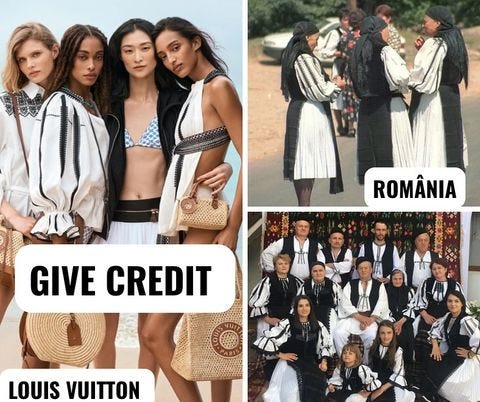#GiveCredit Campaign: Why Giving Credit for Designs Matters
Cultural Appropriation vs. Appreciation: Why Fashion Must Honor Its Roots
Fashion is often seen as a reflection of culture, history, and even the stories we carry through generations. For me, growing up in Romania, the traditional "i.e." (blouse) was more than just a piece of clothing. "IE," or as many may know it internationally, thanks to Henri Matisse's "La Blouse Roumaine," represented craftsmanship, tradition, and a connection to the women who had hand-sewed each one, telling a story through its intricate designs.

Lately, I've noticed something problematic: many global brands are drawing inspiration from Romanian traditional designs, especially the "ie," without giving credit where it's due. As someone passionate about sustainability and ethical fashion, I believe it's essential to recognize and respect cultural heritage, not just borrow it for profit.
The Romanian IA embodies an exclusively feminine blouse, defined by motifs and lush embroidery. It is handmade and designed to be worn for sacred ceremonies or celebrations. Traditionally, the art of sewing and the composition rules are passed from generation to generation. This also adds value to the semiotic structure of the blouse, creating coding markers for the wearer’s character, social status, and personality traits.
As shown in the figure below, the chronicles contain symbols such as the snake (epitomizing renewal or continuity, depending on its linear course), the wheel (embodying the peaceful character of a community or village), the eye (used to protect against curses), or the galaxy (symbolizing the religious aspects of a group and how it perceives life and death). Certain symbols can also recur on skirts, cords, and kerchiefs (shawls)
One campaign that resonates with this idea is the #GiveCredit initiative. It advocates for acknowledging the original designers and artisans behind cultural pieces, especially in an industry where cultural appropriation often runs rampant. A prime example is the famous "La Blouse Roumaine," which has inspired artists like Henri Matisse and fashion houses like Yves Saint Laurent. The beauty of the "ie" is undeniable, but its roots in Romanian folklore and the work of skilled artisans should not be overlooked or erased. Western labels have been stealing African aesthetics for years; here are just eight examples.
Cultural appropriation in fashion happens when elements of a culture are used by others, often out of context and without credit to their origin. While it's natural for fashion to draw inspiration from many sources, it becomes problematic when the communities that created these designs are left out of the conversation and, sometimes, the profits.
Take Dior, for instance. A few years ago, they featured a piece in their collection that looked strikingly similar to traditional Romanian clothing. The result?
A high-end item without acknowledgment from the Romanian artisans who originated the design, it was sold for a price far beyond what the original creators could imagine. This led to the rise of the #GiveCredit campaign, which called out this injustice and highlighted the need to recognize the source of these designs. It also gave rise to Bihor Couture, a Romanian brand selling authentic traditional clothing, assuring local artisans benefit from their work
It's not just about pointing fingers but about starting a larger conversation on ethical fashion. Giving credit means more than tagging a source in a post or collection; it's about understanding a design's cultural significance, history, and meaning. It's about supporting the artisans who carry these traditions forward, ensuring their craft remains alive and respected.
There's an opportunity here for us to be more thoughtful about where our clothes come from and who benefits from the trends we enjoy. By supporting authentic brands and artisans, we can ensure that traditional crafts like the Romanian "ie"are honored and preserved for future generations. Fashion is, after all, a living history, and we are responsible for telling it right.
Recently, I've noticed another disheartening case of cultural borrowing. Mango, a well-known fashion retailer, released a jacket featuring intricate embroidery. It's undeniably stunning, but the design is not their own. The embroidery is rooted in the rich traditions of the Romanian/Hungarian community from the ethnographic region of Ţara Călatei—Kalotaszeg, in Transylvania, Romania. This unique embroidery style, called "Írásos," uses wide stitches to form lively lines that create beautiful patterns like tulips, roses, leaves, and birds.
What's frustrating is that while Mango notes the jacket is "designed in Barcelona" and "Made in China," it does not mention its cultural origin. Traditional art deserves recognition, especially from living communities that have preserved these techniques for generations. The #GiveCredit campaign ensures that artisans and cultural traditions are acknowledged in fashion.
We hope that Mango and other brands will start celebrating the heritage behind such unique cultural treasures by giving credit where it's due. Fashion is not just about trends—it's about honoring the stories behind the designs. When you wear a piece like this, you're wearing history.
I really hope you're enjoying The Sustainability Pulse, my weekly newsletter looking at sustainability in the fashion industry. If you find the tips and insights useful, please share these articles to help spread the word.
Vera Lovici
Please feel free to follow me on LinkedIn if you want to discuss anything sustainability-related!








Thank you, such an important topic! I wasn’t familiar with Romanian traditional design before, so very informative too. It reminds me of Karelian embroidery (where my mother’s family comes from) that has a similar cuckoo (kukkilintu) symbol for happiness and all the good things.
I've been trying to not buy anything new for about a year --- big fan of secondhand shopping, been using some fun tools to make it easier like the chrome extension that finds me resale alternatives for the items I'm looking at as I shop bit.ly/Phia
Hope this is helpful for people!